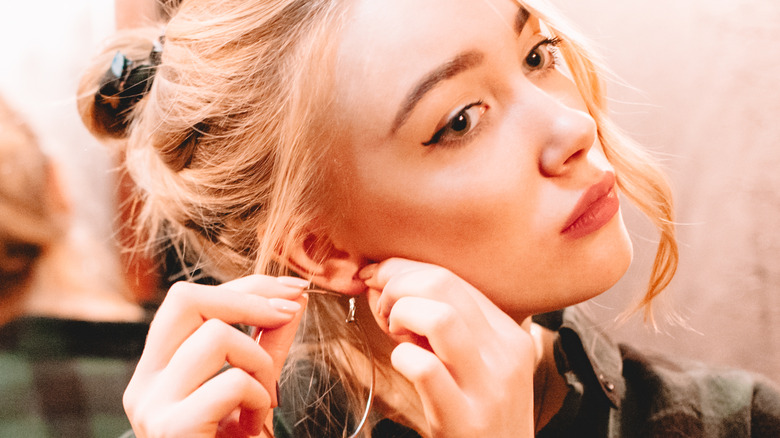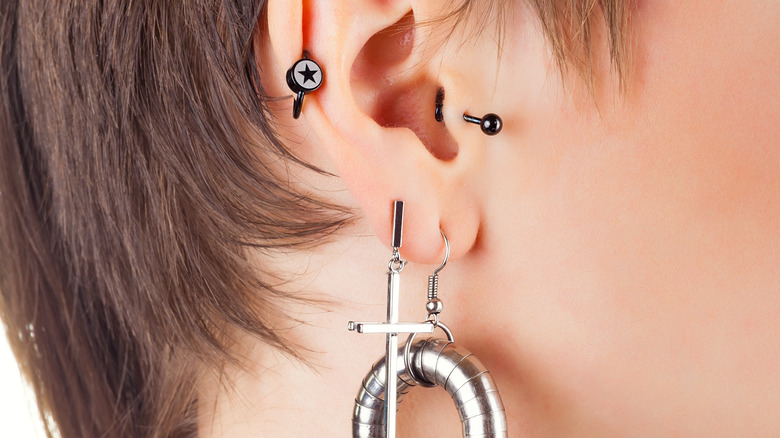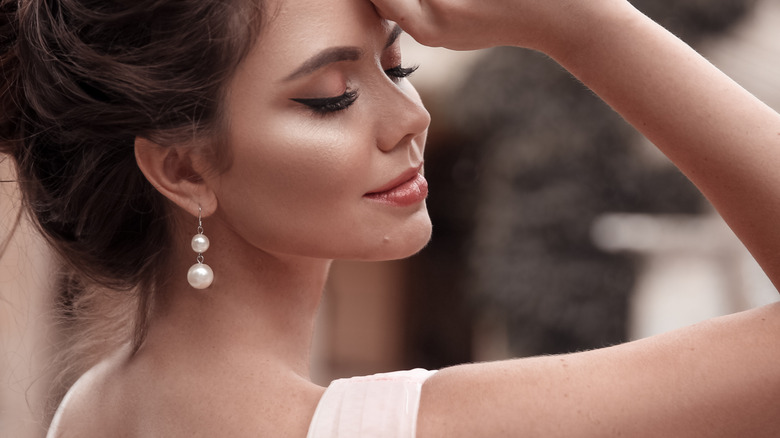What To Do If A Piercing Hole Closes
For those who've had their earlobes pierced for earrings, one of the biggest pet peeves must be when an earring post or hook cannot fit through the tiny piercing hole. This is because the gauge size is too large for your piercing hole, or your hole has already closed up after a lengthy period of not wearing earrings. In other words, a layer of skin forms over the piercing hole over time, making it hard for jewelry to pass smoothly, as dermatologist Rachel Nazarian explained to Byrdie.
When that happens, many people's first reaction is to aimlessly force the jewelry into the fatty tissues of their piercing to see if the post can pop through. And when they can't, many give up while some grab a piercing gun or needle to crack open the hole. The next time you find yourself in this situation, don't force or fire anything through your lobe. Without proper sterilization and the right material, you'll end up with an inflammatory piercing and require medical attention, according to Don't Forget the Bubbles.
As mind-boggling and potentially bloody this situation is, it's bound to happen as long as you still have a passion for wearing danglers. To better prepare yourself for the problem and get your earrings back into the closed holes, here's what you need to know.
How to prevent a piercing hole from closing up
In general, a piercing done more recently will heal and close faster than one that is older and more established. The science behind this paradox lies in your immune system, which activates the healing process the moment a wound is created and makes the hole shrink within a few hours of removing your earrings, explains Studs co-founder Lisa Bubbers to Today.
Typically, a new piercing tends to close within six to 12 weeks, depending on various factors such as the type of piercing as well as the person's immune system. Cartilage piercings, such as those on the helixes, septum, and the nostril area, will take several months to close up without jewelry. Therefore, to keep your piercing in tip-top shape, leave the earrings on for at least six weeks, even at night, per The American Academy of Dermatology. At the same time, wash your ears with soap and water at least once a day to stave off complications. Basically, no fully shaped holes are permanent, and you'll always need to wear earrings to keep them open. It's inconvenient to wear jewelry all the time, so you might want to stick with something that's lightweight.
How to reopen a piercing hole safely at home
When you're past the preventive stage, you might need to learn some foolproof techniques to get your piercing hole open by yourself. Even when you're running late for a date, resist the urge to brutally pop anything through your lobes without washing your hands thoroughly and disinfect your earrings first. To start with, wash the front and back of your earlobe with alcohol, says pediatrician Dr. Jennifer Shu (via CNN). Or, you can soften your skin with warm water and lubricate your piercing with a non-antibiotic ointment such as Vaseline to help the earrings get through more easily. Then, gently stretch your piercing site to make the hole as large as possible to find the right angle to put the jewelry back in. Once the jewelry is successfully re-inserted, leave it on for a few weeks or months to keep the hole sturdy.
If your piercing hole is completely sealed from behind or front, there's no point in forcing your jewelry through. When you meet resistance, stop pushing. In this case, you might need a new piercing, which is better done by a well-equipped professional in a sterile environment to reduce the risks of infection, allergy reaction, or scarring. In case your old piercing hole used to sustain an infection, you might want to get a piercing in another spot, per Healthline. In case you have sensitive ear skin, remember to check with an expert on the type and material of earrings that can offer you maximum comfort.


